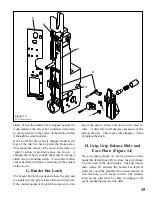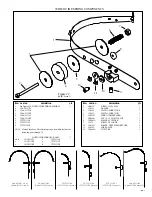
19
N. Supporter
The supporter furnishes the necessary support to the
inside surface of the stitch so that it does not buckle
as it is being driven into the work material. A lack
of (or insufficient) support will often cause the stitch
crown to wrinkle or the legs of the stitch to buckle.
Tighten the supporter spring bushing (Index A, Fig-
ure 18) or replace the spring.
the wire points straight down as in figure 17. Im-
proper straightening of the wire can also cause the
stitch legs to buckle or turn out because they strike
the clincher improperly. Excessive tension on the
wire straightener prevents the grip (Index D) from
feeding the wire smoothly. This causes variation
in leg length.
NOTE:
Check the wire straighteners when changing the
coils to insure the accurate feeding of wire.
If the corners of the top surface of the supporter are
too sharp, or nicked, the corners of the stitch crown
will fracture. If operating properly the supporter
should function as follows:
1. When the bender bar touches the work material
and the legs of the stitch are about to leave
the bender bar grooves the supporter should be
touching the underside of the crown.
2. As the stitch is driven through the work the
supporter is gradually retracted by the driver.
It should remain under the crown of the stitch
until the last instant before the crown touches
the work material.
O. Tension Pawl: (Figure 19)
The tension pawl (Index A) and spring (Index B)
apply pressure on the wire to prevent back feed. If
the pawl becomes worn or the spring becomes weak,
the wire feeds backwards resulting in a short wire
draw. Reverse or replace the tension pawl and/or
spring.
A
A
B
Figure 19
(CTTT2605 Scene 18)
Figure 18
(CTTT2605 Scene 11)









































